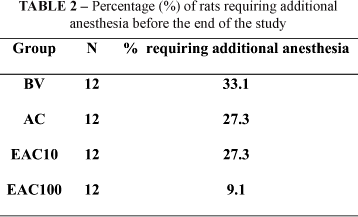PURPOSE: To evaluate the possible beneficial effects of electro-acupuncture in rats subjected to ketamine/xylazine (KX) intra-peritoneal (i.p.) anesthesia. METHODS: Forty-eight male Wistar rats were distributed in four equal groups. All rats received i.p. injections of ketamine (90 mg/kg) +xylazine (10 mg/kg) anesthesia. Basal values group (control) rats (BV) received no additional treatment. The equivalent of the human right ST36 (Zusanli) and CV-12(Zhongwan) acupoints were chosen for needling and electrical stimulation. AC rats were needled with sterilized disposable stainless steel needles at right ST36 and CV12 acupoints; needles were retained for 30 minutes. EAC10 rats, after needle insertion as described, had electrodes connected to both needles and to an electro stimulator model NKL EL-608; pulsed square waves, 10 Hz, 10 mA, was applied for 30 minutes. EAC100 rats were submitted to EA as described. However, a greater frequency (100 Hz) was used. RESULTS: Thirty-seven rats remained under adequate anesthetic level during the experiment. However, maintenance anesthesia was required by 11 rats. Need for additional anesthesia decreased to 9.1% in EAC100 rats compared to BV (36.3%). CONCLUSION: Both the AC and the EAC10/100 prolong the anesthetic effect of the combination Ketamine-xylazine in rats, allowing longer duration of anesthesia with a lower dose of anesthetic, thereby reducing the occurrence of complications.
Ketamine; Xylazine; Anesthesia; Acupuncture; Eletroacupuncture; Rats



